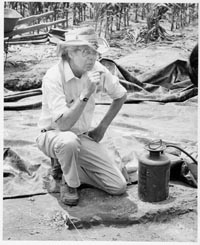Sidebar 3: What is it? What Does it Mean? - Lu Ann De Cunzo

James Deetz at work at Flowerdew Hundred, Virginia, in the mid-1980s. (Photograph by Gene Prince, courtesy of the Phoebe Apperson Hearst Museum of Anthropology and the Regents of the University of California.)
What is it? What does it mean? These deceptively simple questions belie the complexity and fundamental importance of material culture studies to historical archaeology. Archaeologists build our interpretations of past peoples, cultures, and histories on the foundation of these studies of what people made and threw out, lost, or otherwise left behind as a record of their existence. Many archaeologists devote their careers to learning from ceramic pots, glass bottles and beads, clay tobacco pipes, and every other thing that we find.
From our first questions flow a host of others that hint at the challenge posed by every excavated object. What is it made of? Why does it look like that? How does it work? When was it made? How was it made? Where was it made? Who made it? Who used it, and for what purposes? What does it mean to its users? How did it get to the place where it was found? You get the picture.
We begin by identifying and classifying artifacts based on comparisons with others. Here we face our first challenge. On what do we base our classification, physical features that the archaeologist thinks are important, or those that the people who made and used the artifact thought were important? Careful physical and, sometimes, chemical analysis of the artifact reveals details of form, color, design, and composition that allow us to group artifacts into standard descriptive categories. A crucial goal of these archaeologists’ classifications, or typologies, is to tell time.
Roderick Sprague and Karlis Karklins, for example, detailed typologies of the tiny glass beads that have adorned European, Native American, and African American clothing and other objects for centuries. Iain Walker crafted typologies of Dutch and English tobacco smoking pipes that allow archaeologists to determine their place of origin and estimate their production date based on the shape of the bowl, length and bore diameter of the stems, and molded and stamped markings. And a well-worn copy of Ivor Noel Hume’s A Guide to Artifacts of Colonial America anchors the bookshelf of every self-respecting historical archaeologist. Otherwise known as the “colonial artifact bible,” this Guide by Colonial Williamsburg’s emeritus archaeological director covers everything from armor to wig curlers, including the finer points of dating a chamberpot by the shape of its rim.
Artifacts are more than tools to tell time for archaeologists. Through our studies of manufacturing technique, we write the history of technology from bricks and toys and buttons. Following the travels of objects as commodities from producers to consumers, we write the history of trade and exchange from ceramics and bottles. George L. Miller has led our studies of these industrial commodities, unraveling the complexities of how innovative technologies, availability, price, form and decorative style, marketing, and fashion came together to shape choice during the “consumer revolution.” He has computed indices for analyzing consumers’ economic investment in 19th-century ceramics and applied today’s economists’ “market basket” to evaluate the significance of those investments. These economists’ tools open a window into the meanings people gave to objects and why they made the choices they did. Ivor Noel Hume named his recent book, If These Pots Could Talk. The title alludes to the passion he shares with all historical archaeologists to know the people behind the pots, and the world those people knew. That’s what we mean by “unlocking the past.”